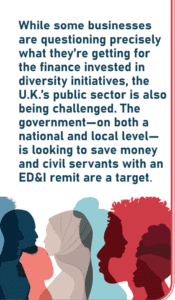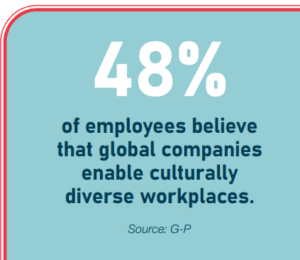Even in challenging economic times, building a diverse and inclusive workforce pays dividends.
By Simon Kent
The movement on equality, diversity, and inclusion (and latterly belonging) has grown over the years. A number of studies have indicated successes which can be attributed to promoting diversity across business operations. Why would any business not want to ensure it is open to the widest range of talent, able to welcome anyone, and offer a level playing field for candidates, employees, and customers? However, as budgets tighten and businesses focus on bottom line impact, the ED&I agenda must renew the fight to maintain its place within organisations.
While some businesses are questioning precisely what they’re getting for the finance invested in diversity initiatives, the U.K.’s public sector is also being challenged. The government—on both a national and local level—is looking to save money and civil servants with an ED&I remit are a target. The Chancellor of the Exchequer, no less, has said he finds some diversity schemes “hard to defend” as a use of public money.
“In a challenging economic climate, it can be tempting for businesses to make cuts to diversity, equality, and inclusion initiatives,” agrees Sandi Wassmer, CEO of U.K.-based Employers Network for Equality & Inclusion (enei). “Some may think it is an easy, cost-saving measure that will have little impact on the bottom line. But this is a false economy.”
Wassmer explains that organisations with inclusive cultures benefit from happy, fulfilled, and thriving employees. “They have a visceral sense of belonging, feel psychologically safe, trust that their views are listened to and acted upon, and can bring their whole selves to work,” she explains. “If employees feel all these things, then they are more likely to be productive. And creating a productive culture is just good business sense.”
While acknowledging the debate around the ROI of ED&I initiatives, Wassmer says that her own organisation sees many members recognising the connection between the two. “If you have a happy, thriving workforce and an inclusive culture, you’ll find it much easier to attract and retain staff. This has a double benefit for businesses. Not only will your recruitment costs be lower as a result of reduced staff turnover, but a diverse workforce is also much more likely to reflect the full spectrum of needs of your customers and clients. Meaning you’ll also be providing a better service overall.”
Miles Lloyd, co-founder of business mentors Northstar People, says that when his clients understand the power ED&I can have in the recruitment process, the approach becomes a must-have. “When I share with recruitment agency leaders, the experience I’ve had when shaping, building, launching, and then executing an ED&I-led recruitment value proposition process for agency clients then the ROI penny drops pretty quickly, and from multiple perspectives,” he says. Lloyd cites guaranteed fees, high levels of repeat clients, and C-suite client engagement all stemming from an ED&I awareness.
“Agencies I’m working with have rapidly moved beyond just providing ED&I-led recruitment or hiring solutions and are by client demand now delivering both ED&I recruitment workshops and talent consultancy to their clients,” he adds.
“The issue with ROI,” says René Bujard, HR director, EMEA, at health and engineering business Sunstar Global, “is that it only measures the what and not the how the results are achieved. Wise shareholders and board members should demand a more complete assessment of results that balances ROI and employee engagement scores. If both metrics are high, there is in my experience a stronger likelihood that the results are sustainable.”
Bujard reports that he has seen ED&I becoming more connected to the broader ESG agenda of companies bringing with it a clearer focus on hard metrics. “On the one hand it gives ED&I a renewed legitimacy and momentum because it is now an expectation of mainstream investors that cannot as easily be ignored or deprioritized,” he says. In other words, these initiatives can no longer been seen as just a “bolt on,” available should the business have time for such things. But Bujard warns there’s a sting in the tail: “The risk with this integrated approach is that resources previously allocated to ED&I work may be reprioritised towards sustainability interventions which, like ROI, can also deliver easy marketable progress.”
Laura Maffucci, head of HR at global employer solutions company G-P, says the payoff between ED&I and ROI is by no means proved. “Many reports have found that organizations that embrace employees from diverse backgrounds enjoy a diversity of talent and thought, obtain higher engagement rates, and also achieve greater innovation and business performance.”
That said, Maffucci is clear that ED&I cannot be implemented as a one-size-fits-all policy across global businesses and she acknowledges that while in some countries, these practices can be simply a nice-to-have, in others there are legal requirements that need to be met. “When operating in multiple regions, businesses must adapt their diversity and inclusion strategies to fit the local context culturally and regulatory, while still upholding general corporate values,” she says.
This then alters the perspective on ED&I a little. If culturally it feels less significant, then the chances are a business operating in that location will perceive less “return” on their investment than a business which works where there is greater acknowledgement of diversity.
“G-P’s research shows that 48% of employees believe that global companies enable culturally diverse workplaces, it’s fair to say a global workforce is a great starting point to support diversity,” says Maffucci. “It’s business leaders’ responsibility to design ED&I strategies that promote a healthy, open-minded, welcoming culture while ensuring a workspace that is compliant with legal and cultural standards in every corner of the earth.”
It may yet be too early to say that ED&I is being sidelined by companies, it is perhaps more accurate to suggest companies are seeking to be more strategic in its positioning. In the current economic climate, all financial outlay is under particular scrutiny and finding the right way to invest in and measure the impact of ED&I, in terms of what it requires from a business and what it gives back, will secure its place on the business agenda going forward.
















